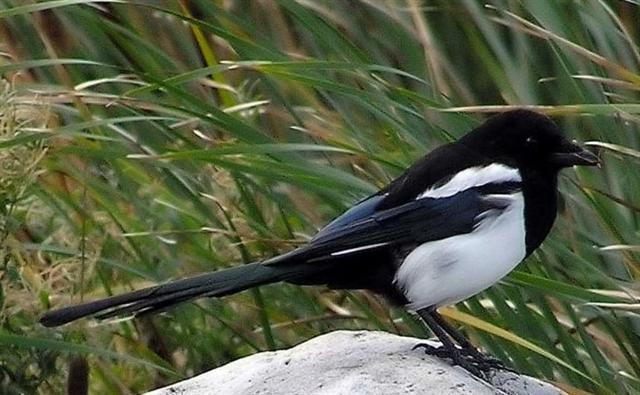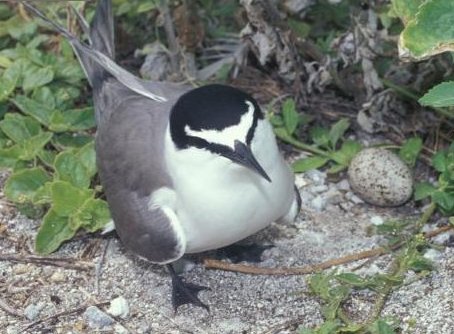|
"Day of the Winter Solstice - A - aidhircleóg, lapwing; alad, piebald. Why is the Lapwing at the head of the vowels? Not hard to answer. It is a reminder that the secrets of the Beth-Luis-Nion [the ABC of the pre-latin Ogham alphabet] must be hidden by deception and equivocation, as the lapwing hides her eggs. And Piebald is the colour of this mid-winter season when wise men keep to their chimney-corners, which are black with soot inside and outside white with snow; and of the Goddess of Life-in-Death and Death-in-Life, whose prophetic bird is the piebald magpie." (The White Goddess) "piebald ... of two colours mingled, esp. white and black ... f. PIE¹ + BALD (in the sense 'streaked with white' ..." "pie¹ ... MAGPIE ... L. pīca magpie, rel. to pīcus green woodpecker, and Skr. pikás Indian cuckoo, and referred by some to IE. *(s)pl- be pointed ..." "magpie ... common European bird, Pica caudata, noted for its noisy chatter and pilfering habits ... f. Mag, pet-form of Margaret + PIE¹ ... Earlier (dial.) maggot-pie ... f. Maggot - (O)F. Margot, pet-form of Marguerite Margaret ..." (English Etymology) |
||||||||||||||||||||||||||||||||||||||||||||||||||||
|
Black with white streaks, a crooked bird (pilfering habits) and ultimately with a meaning 'to be pointed'. We can identify the magpie of Easter Island with manu tara.
The 'corner of the house' should refer to a cardinal point. The eggs of the 'lapwing' are located at the three islets outside Orongo. There they stole the first manu tara egg of the season (as if mimicking the pilferous magpie).
|
||||||||||||||||||||||||||||||||||||||||||||||||||||
|
In Latin tara becomes Spica, and we can remove that S because IE. *(s)pl- is 'to be pointed'. "Spica signifies, and marks, the Ear of Wheat shown in the Virgin's left hand ... In Chinese astronomy Spica was a great favorite as Kió, the Horn, or Spike, anciently Keok or Guik, the special star of springtime; and with ζ formed their 12th sieu under that title. " (Allen) The magpie is black and white (suggesting both halves of the year), though in the sunshine she has all the colours. My memory insists I should consider a book I read half a lifetime ago: The Mathematical Magpie by Clifton Fadiman (1962). I searched for it in my library and found the book. What had induced Fadiman to include a magpie in the title? On the hard cover the titel reads The Mathematical Mag π. A joke, maybe, or maybe not. Mag for magazine and π for pie. A magpie is a collector of all sorts of things and Fadiman had assembled in his 'magazine' all sorts of mathematical curiosities. A pie is a dish composed of various ingredients: pie² ... dish composed of meat, etc., enclosed in paste and baked ... it has been conjectured that the reason for the application is that the magpie collects miscellaneous objects †chewet meat or fish pie (perh. identical with F. chouette †jackdaw, now owl) and HAGGIS have been compared ... haggis ... dish consisting of minced entrails of a sheep, etc., boiled in the maw of the animal ... of unknown origin; identity of form with †haggess magpie has suggested the possibility of its being a transf. use of the source of this, (O)F. agace, agasse magpie - OHG. agaz(z)a ... (English Etymology)
|
||||||||||||||||||||||||||||||||||||||||||||||||||||
|
The pilferous bird (manu tara) should be an aspect of the quick-witted Mercury (Hiro). In the bird list manu tara comes first:
The sooty (as if having arrived through a chimney) tern announces spring. And if it should be equivalent with Spica (Cabo Norte), then the kena bird could announce the beginning of waning (item 21 in the 2nd list of place names):
Maybe it means Anakena is the birth station of waning?
|
||||||||||||||||||||||||||||||||||||||||||||||||||||
|
manu tara (with sooty back)
kena (with white back) |
||||||||||||||||||||||||||||||||||||||||||||||||||||


